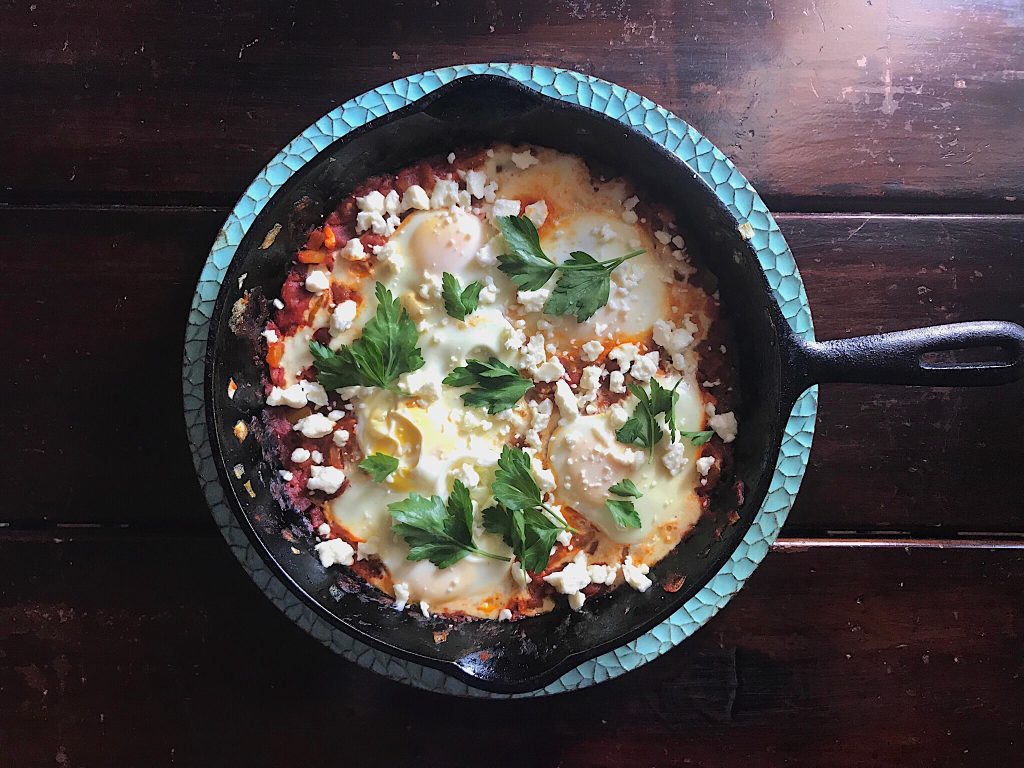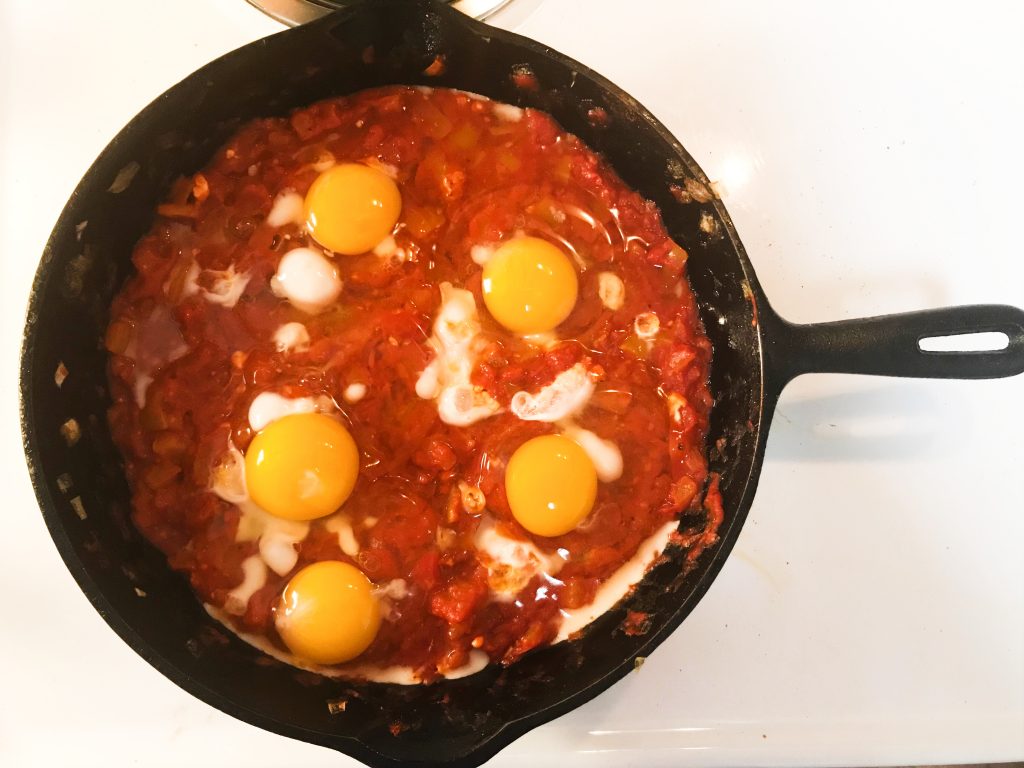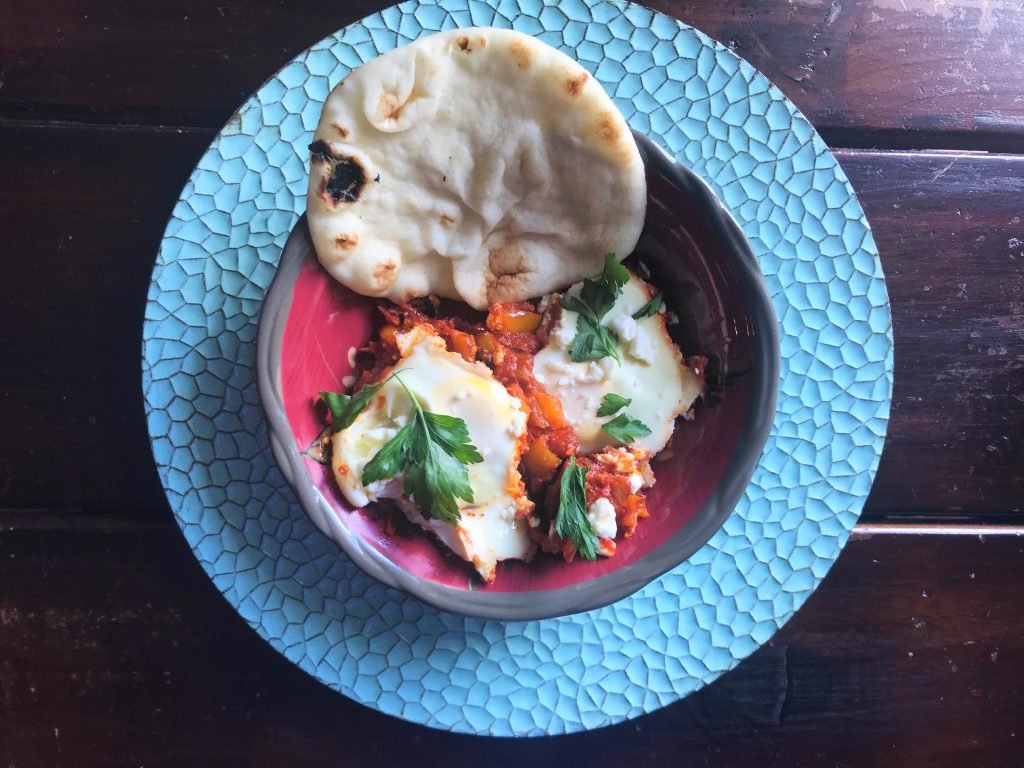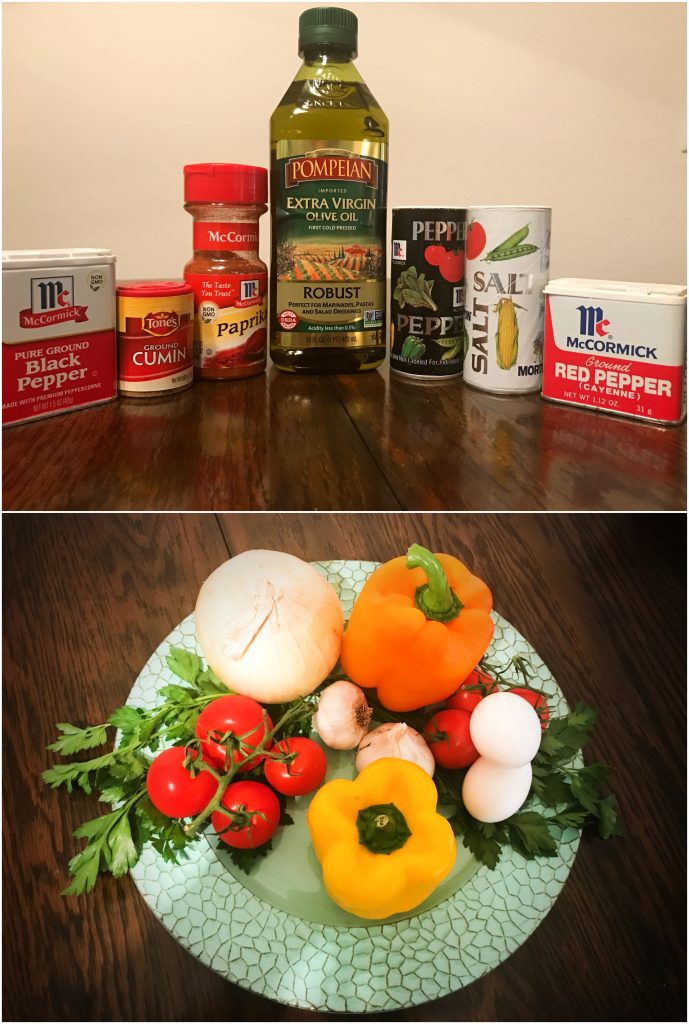Shakshuka
By Katie_Bohannon • December 13, 2018

With a topography as diverse as its passionate people, Israeli cuisine is an exquisite blend of history, religion, and culture from a myriad of countries. In a sea of such incredible variation, finding the perfect recipe to navigate through Israeli cuisine’s choppy waters might appear daunting…but with a little faith, and a determined spirit, I am convinced such a task is far from impossible. Oh, and the internet often proves quite the helpful tool.
As I researched Israeli cuisine, I found that despite the subtle differences in ingredients, there were patterns throughout the nation’s food—recipes that emerged over and over again, dishes that built bridges and brought people together. Vegetable salads, hummus, and falafel were three that sparked my interest, but one meal—Shakshuka—emerged as the perfect choice.
A conventionally Jewish breakfast recipe that immigrated to Israel from North Africa, Shakshuka is a dish traditionally cooked in a cast iron skillet, consisting of poached eggs sitting atop a rich sauce of tomatoes and sautéed vegetables. Like all Israeli cuisine, Shakshuka has evolved over time, resulting in numerous recipes with varying ingredients, morphing into a dish that reflects the individual’s personal preferences, and growing into a meal served for breakfast, lunch, and dinner.
Preparing this meal was something new for me, much like the first day of school. After reading several recipes, I found myself filled with a vague understanding of the process, like walking onto campus after the summer months fade away. But the anxiety that comes with unpredictability had the fear of the unknown tapping me on the shoulder.
As someone who has never really cooked with a cast iron skillet in the past, I was unaware that you must season the skillet before you actually use it. (Unless, of course, you do frequently cook with a cast iron skillet, in which case, you have most likely already seasoned it. If you haven’t, then I’m not sure what happens, but from the sound of desperate urgency in my mother’s voice, I would imagine that the skillet would explode, thus making your cooking experience less enjoyable.)
I seasoned my skillet the night before preparing this meal, which basically consisted of me scrubbing the skillet profusely with Dawn dish soap, drying the pan with a dish rag, drizzling some canola oil into the skillet (then immediately wiping the oil off with a paper towel), and placing the skillet upside down into an oven heated at 350 degrees. This process sounds far more complicated than it actually is, so I’ll include a link here that hopefully simplifies everything I just described.
The following morning, with the sunlight filtering softly through my curtains, my hair swept up messily in a bun, my cast iron skillet beautifully seasoned, and a quiet determination for success swelling in my heart, I began my Shakshuka adventure.
First, I turned to the vegetables: specifically, the onion, bell peppers, and tomatoes (calling a tomato a fruit just sounds wrong, even if it’s technically correct). These ingredients, along with the garlic, required some preparation before I cooked them in the skillet. I began by chopping 1 sweet onion into finely diced pieces.
I won’t lie, I consulted several Gordon Ramsay videos on YouTube during this portion of the recipe. There is a ‘proper’ way to chop all foods in the culinary world, and since I longed to create the most wondrous Shakshuka I ever tasted, I didn’t mind taking the time to consult some outside help. If you are an inexperienced chef, save your mascara from running or eyes from burning here.
Next, I sliced 2 bell peppers according to this method. When sautéing vegetables, some prefer to leave the bell pepper in long strips. However, for Shakshuka and my own personal preference, I wanted bite-sized portions, so I chopped the bell pepper into square-like chunks, similar to the onions. Then, I sliced and chopped the tomato to achieve the same result of small dices.
My vegetables chopped, separated, and ready for sautéing, I reached for a single head of garlic. The onion, bell pepper, and tomatoes went smoothly, and at this point, my confidence was soaring. I had cut onions without crying, I had sliced bell pepper while leaving the seeds intact—I was Wonder Woman. Chopping garlic should prove just as easy, right?
Wrong.
My first attempt at breaking the cloves from the bulb didn’t quite do anything, so I thought perhaps I might add more force. I slammed the base of my palm down onto the head of garlic, which definitely emancipated the cloves, while simultaneously sending half of them flying across my kitchen. I then tried to peel the skin from the cloves, which resulted in many layers sticking to my fingers. Once I began finely chopping the cloves, (for this recipe, I chopped about 3) the powerful, recognizable smell that engulfed my apartment made me understand why garlic repels vampires.
After my nostrils recovered, I poured 3 tablespoons of extra-virgin olive oil into the skillet, and began heating it over medium-low heat on the stovetop. Then I added the onion and garlic, sizzling them in the skillet for about 10-15 minutes.
Next, I added the bell peppers, and cooked them for about 10-15 minutes as well. I then added 1 teaspoon cumin, 1 teaspoon paprika, and 1/8 teaspoon of cayenne. The crackling, popping melody of the bright yellows and reds in the skillet proceeded a delightfully smoky, rich aroma that began flourishing throughout my kitchen, eliminating my garlic mishap as an embarrassment of the past.

In my research of Shakshuka, I found a variation of the types of tomatoes preferred for this dish. Some recipes call for canned tomatoes; others concoct a mixture of fresh tomatoes with tomato paste, which is the option I selected. Mixing in the tomatoes first, I let them soften for a few minutes before stirring in the tomato paste, which I then let simmer (again, 10 minutes) until the heated, bubbling paste morphed the sautéed vegetables into a thick, crimson sauce.
The eggs came next. To avoid any unwanted shells falling into the simmering sauce, I cracked the eggs into a small glass bowl before I poured them into the skillet. (I didn’t crack them all at once—I repeated this method five separate times, so that only one yolk was in the bowl at a time.)

Don’t worry if you break any yolks during this step; I’m sure they would taste the same either way once cooked. That being said, the first egg I attempted to crack slid into the glass bowl with a plop, the golden yolk bursting and oozing into the clear liquid as I watched in horror. I automatically banished it to a life of disgrace in the garbage.
This step is another moment where Shakshuka recipes drift into murky waters: some suggest placing the skillet into a 375-degree oven for 7 to 10 minutes, while others suggest simply covering the skillet over the hot stovetop. I chose the latter route, and lacking a lid for my skillet, I instead placed a stainless-steel cookie sheet over the skillet and waited the allotted time.
For the grand finale, I sprinkled the crumbling feta over the cooked eggs and sauce. The two main recipes I followed call for cilantro as a garnish, but as I was plucking fragrant, green leaves and sprinkling them over the top of the Shakshuka, I realized I purchased parsley instead of cilantro at Fresh Market. You can either disregard my herbal ignorance, making sure to thoroughly read labels while shopping for your own ingredients, or you too can choose the road less traveled, and add parsley to your Shakshuka.
Whether you are eating this meal straight from the skillet, your family serving themselves heaping spoonfulls with smiles, or enjoying a bowl of Shakshuka in pleasant solitude, eating this dish with bread is mandatory. The combination of the sweet, soft, and warm Naan along with the smoky, savory flavor of the Shakshuka was quite unlike anything I’d ever tasted in my own kitchen. Such an intriguing blend of flavors prompted me to wonder if I had done this dish justice, yet while I ate half the skillet myself, I predict that cooking Shakshuka again (and hopefully with more success) is a treasure buried within my future.

Ingredients and Preparation
Note: The measurements of these ingredients can change due to your own preferences. For example, if you prefer more bell pepper than onions, or vice versa, feel free to add different portion sizes.

Ingredients:
3 tablespoons extra virgin olive oil
1 sweet onion, diced
1-2 bell peppers (red, orange, or yellow), diced
3 garlic cloves, thinly sliced
1 teaspoon ground cumin
1 teaspoon paprika
1/8 teaspoon cayenne, or to taste
1 28-oz can diced tomatoes with juices or 2 large Roma tomatoes with tomato paste
1 ¼ cups crumbled feta cheese, or to taste
5-6 eggs
Chopped cilantro, for serving
Preparation:
- In a cast iron skillet, heat 3 tablespoons of extra virgin olive oil over medium-low heat. Add diced onions, garlic, and bell pepper to the skillet, cooking them for around 10-15 minutes, or until they soften.
- Stir in cumin, paprika, and cayenne. Allow the spices to cook for 1 minute before adding the tomatoes (either canned or fresh tomatoes with tomato paste). Cook tomatoes for around 10 minutes or until they thicken, creating a rich, bubbling sauce.
- Optional: Sprinkle feta into the sauce.
- With a spoon, make 5 little indentations into the sauce, mirroring tiny bowls in the skillet. In a separate bowl, crack 1 egg and pour the egg into the skillet. Repeat this step until all the eggs are nesting in the tomato sauce. Salt and pepper to taste.
- Cook the eggs covered for 5-7 minutes, or until the whites are mostly set in place. Remove the skillet from the hot stovetop, sprinkle more feta over the top, and garnish with cilantro. Serve hot with bread and enjoy!
A Final Note: For my version of Shakshuka, I used a combination of several recipes to create my own cooking process, and to tweak certain ingredients to my own taste. Since Israeli cuisine itself is a magnificent blend of endless traditions from an array of countries and cultures, blending recipes to create something new that brings joy to each individual only seems natural in the evolution of Israeli cuisine, and in this case, Shakshuka.
Recipes I consulted:
“Shakshuka with Feta” by Melissa Clark at New York Times Cooking offers a simple guide to Shakshuka as well as a video to accompany the recipe.
“Shakshuka” by Jenn Segal is featured on her food blog, Once Upon a Chef, offering a unique version to the traditional recipe—one that I’d love to try sometime soon.
Visual aid:
“Shakshuka-Eggs Poached in Spicy Tomato Pepper Sauce” by Food Wishes offers the step by step process of creating Shakshuka with some interesting twists, and delightful humor, making the video both informative and entertaining.
“How to Peel and Chop Garlic” by Kitchen Daily is precisely what its title implies. While this video is helpful, the chef refers to chopping garlic as a kitchen basic, which made me feel a little insecure, but for seasoned chefs, this is a breeze.